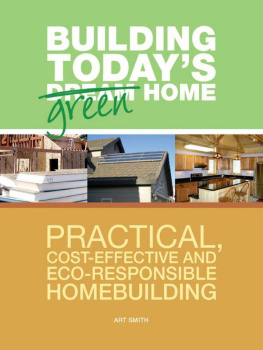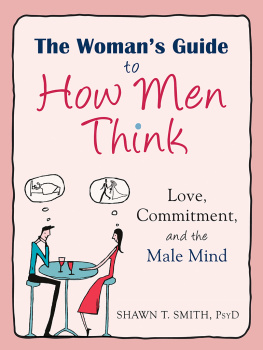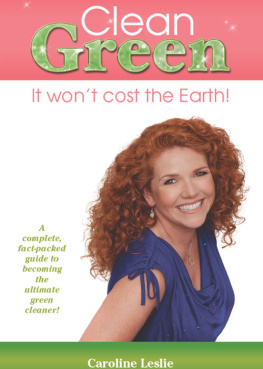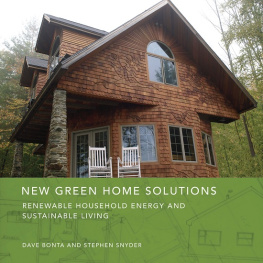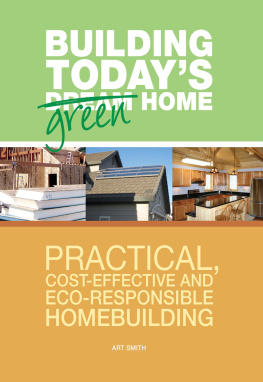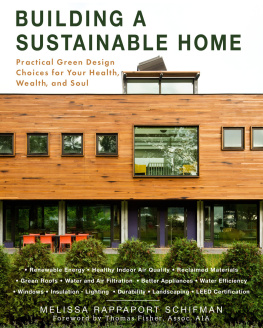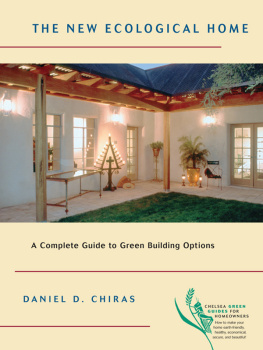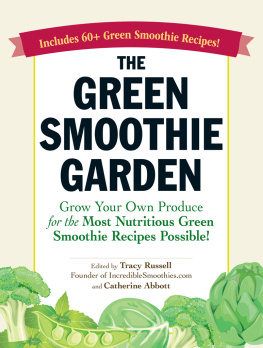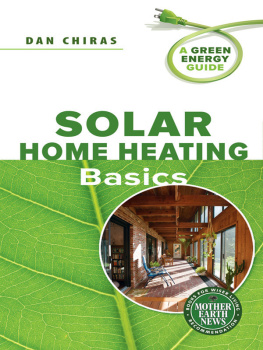

BUILDING
TODAYS
GREEN HOME
PRACTICAL,
COST-EFFECTIVE AND
ECO-RESPONSIBLE
HOMEBUILDING
ART SMITH

BUILDING TODAYS GREEN HOME. Copyright 2009 by Art Smith. Printed and bound in China. All rights reserved. No part of this book may be reproduced in any form or by any electronic or mechanical means including information storage and retrieval systems without permission in writing from the publisher, except by a reviewer, who may quote brief passages in a review. Published by Betterway Home, an imprint of F+W Media, Inc., 4700 East Galbraith Road, Cincinnati, Ohio, 45236. First edition.
Distributed in Canada by Fraser Direct
100 Armstrong Avenue
Georgetown, Ontario L7G 5S4
Canada
Distributed in the U.K. and Europe by David & Charles
Brunel House
Newton Abbot
Devon TQ12 4PU
England
Tel: (+44) 1626 323200
Fax: (+44) 1626 323319
E-mail: postmaster@davidandcharles.co.uk
Distributed in Australia by Capricorn Link
P.O. Box 704
Windsor, NSW 2756
Australia
Visit our Web site at www.popularwoodworking.com.
13 12 11 10 09 5 4 3 2 1
Library of Congress Cataloging-in-Publication Data
Smith, Art, 1948
Building todays green home : practical, cost-effective, and eco-responsible homebuilding / by Art Smith.
p. cm.
Includes bibliographical references.
ISBN 978-1-55870-862-4 (pbk. : alk. paper)
ISBN-13: 978-1-44030-784-3 (EPUB)
eISBN: 978-1-44030-784-3
1. Ecological houses--Design and construction. 2. House construction. I. Title.
TH4860.S62 2008
690.8047--dc22
2008022321

Acquisitions Editor: David Thiel
Senior Editor: Jim Stack
Designer: Brian Roeth
Production Coordinator: Mark Griffin
Photographer: Art Smith
Illustrators: Art Smith and Jim Stack
Read This Important Safety Notice
To prevent accidents, keep safety in mind while you work. Use the safety guards installed on power equipment; they are for your protection. When working on power equipment, keep fingers away from saw blades, wear safety goggles to prevent injuries from flying wood chips and sawdust, wear hearing protection and consider installing a dust vacuum to reduce the amount of airborne sawdust in your woodshop. Dont wear loose clothing, such as neckties or shirts with loose sleeves, or jewelry, such as rings, necklaces or bracelets, when working on power equipment. Tie back long hair to prevent it from getting caught in your equipment. People who are sensitive to certain chemicals should check the chemical content of any product before using it. The authors and editors who compiled this book have tried to make the contents as accurate and correct as possible. Plans, illustrations, photographs and text have been carefully checked. All instructions, plans and projects should be carefully read, studied and understood before beginning construction. Due to the variability of local conditions, construction materials, skill levels, etc., neither the author nor Popular Woodworking Books assumes any responsibility for any accidents, injuries, damages or other losses incurred resulting from the material presented in this book. Prices listed for supplies and equipment were current at the time of publication and are subject to change.
Metric Conversion Chart
| to convert | to | multiply by |
| Inches | Centimeters | 2.54 |
| Centimeters | Inches | 0.4 |
| Feet | Centimeters | 30.5 |
| Centimeters | Feet | 0.03 |
| Yards | Meters | 0.9 |
| Meters | Yards | 1.1 |
About the Author
Art Smith, Residential Designer, LEED AP, has had a special interest in energy-efficient yet practical homes since a crucial college decision to study engineering instead of architecture. Starting with his first passive-solar home, designed in 1980 in an Atlanta suburb, to designing current clients homes, his focus is on balancing low-energy use, low-maintenance and comfortable living particularly for the transitioning baby-boomers. Armed with an engineering and manufacturing background, Art, and his family, escaped the Atlanta high-tech world to the North Georgia Mountains in 2001 to continue this pursuit full-time.

Acknowledgements
To my two sweeties: Nancy & Kristina

The editors would like to thank Art, and his able-bodied photo assistant, Richard, for their above-(literally) and-beyond efforts to get just the right photos for this book.
Photo Credits:
All photos taken by the author except the following:
: courtesy of Elk Mountain Homes
: Courtesy of EnergyEdge
: Courtesy of Rheem Manufacturing Company
: Courtesy of American ALDES
: Courtesy of CONSERV
: Courtesy of RSF Fireplaces
: Courtesy of Infiltec Corporation
: Courtesy of Retrotec
FIGURES : Courtesy of AFM R-Control SIP
FIGURES : photos by Chris Westerman
Contents

Introduction
Ever since I designed and built my first passive-solar home near Atlanta in 1980, and, more recently, clients homes that I have designed, I have been told that I was too far ahead. I was told that We dont build homes that way around here. Curb appeal only is what sells houses. I was advised that homes had to be large to be good. Many of these suggestions were just the current trends or fads. But, what is real now? Our global warming and rising costs situation are not just passing, they are the future reality.
Building green should not be just the latest fad it is a wise thing to do. At this phase of life of the American baby-boomers, I believe we have arrived at a crucial crossroads. We can choose to be smart or we can choose to leave a mess for our children.
Building Todays Green Home will help you cut through the green-marketing hype and make smart choices that yield outstanding results. The eco-friendly sub categories energy efficiency, sustainability, realistic home size, solar power and air quality are thoroughly discussed in this book.
Using Building Todays Green Home , you can start your journey to either building your own home or use it as an aid in selecting a smarter and greener future residence.
And, my wife, Nancy, and my daughter Kristina, would like someone else to hear all this technical homebuilding jargon. They have heard this stuff for years now its someone elses turn!
The Futile Search for the Dream House
BABY-BOOMERS BEWARE! We are consuming our own retirement future as well as our childrens on a futile search for the perfect dream house.
But we have time if we are smart. We can overcome this challenge with help of our typical American ingenuity coupled with the hope that the baby-boomer generation will grasp this opportunity for greatness by choosing a simple concept practical. Before we apply this moderating technique, how did we get to this impractical place?
Next page
